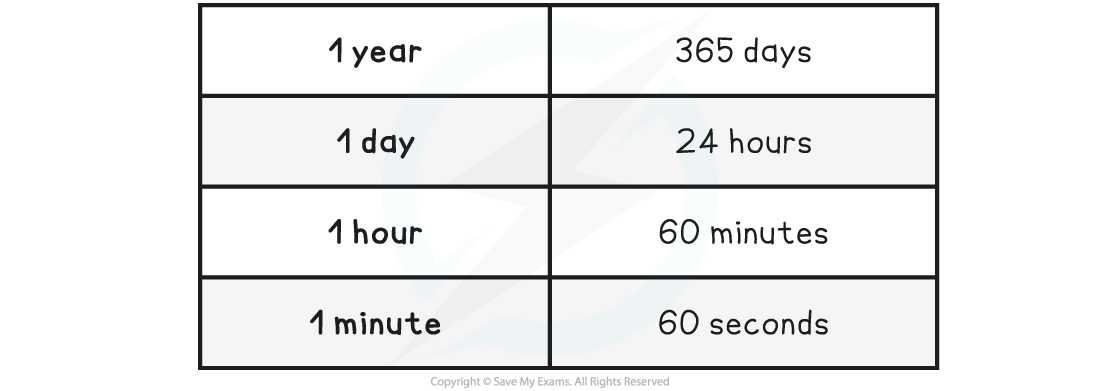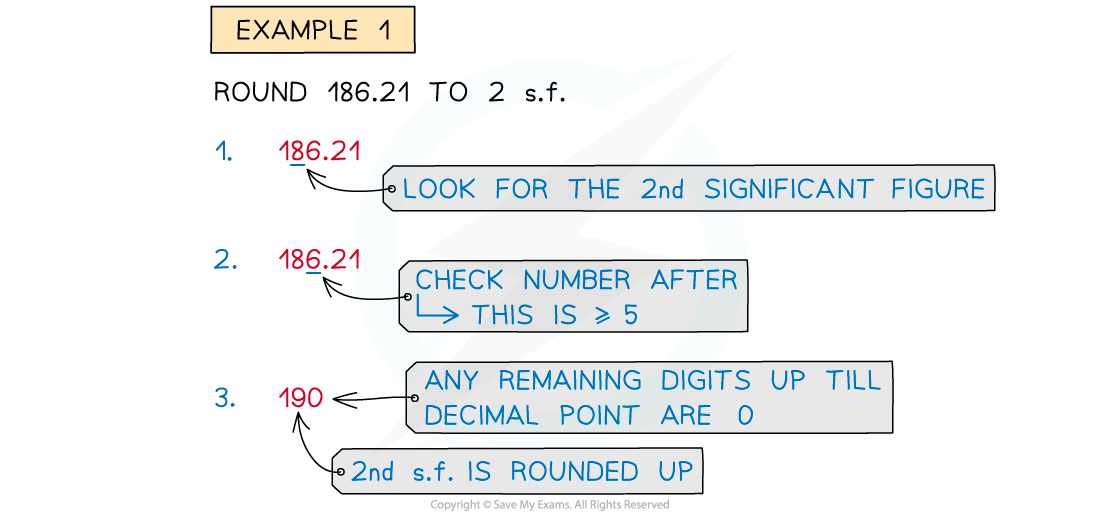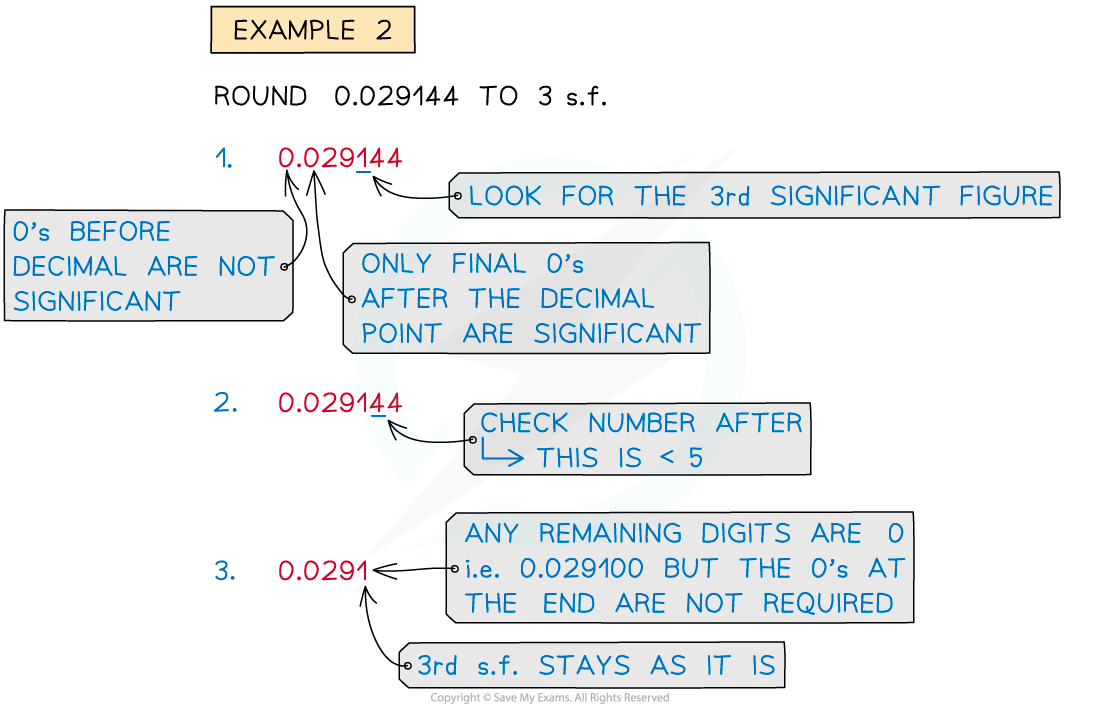Conversions & Standard Form (Edexcel GCSE Physics): Revision Note
Exam code: 1PH0
Conversions
As well as prefix (powers of ten) conversions (eg. km into m) there are also common unit conversions
One such unit conversion are those for time
The main time conversions are shown in the table below:
Time Conversions Table

Hours & Seconds
A common time unit conversion is between hours and seconds
1 hour = 60 minutes
1 minute = 60 seconds
Therefore 1 hour = 60 × 60 = 3600 seconds
To convert from hours → seconds, multiply by 3600
To convert from seconds → hours, divide by 3600
Hours × 3600 = Seconds
Seconds ÷ 3600 = Hours
Kelvin & Degrees Celsius
A common temperature unit conversion is between Kelvin and degrees Celsius (ºC)
The scale is defined as: 0 K = -273.15 ºC
To convert from Kelvin → Celsius, subtract 273.15
To convert from Celsius → Kelvin, add 273.15
K − 273.15 = oC
oC + 273.15 = K
Worked Example
A cyclist takes 3.5 hours to travel to their destination. Calculate their time travelled in seconds.
Answer:
Step 1: State the conversion
1 hour = 3600 s
Seconds = Hours × 3600
Step 2: Calculate the time in seconds
3.5 × 3600 = 12 600 s
Examiner Tips and Tricks
You will be expected to remember these unit conversions in your exam and to confidently convert between them, so make to practice these to achieve full marks in the calculation questions.
Significant Figures & Standard Form
Significant Figures
The significant digits are the digits in a number that contributes to the value of that number
These are sometimes called significant figures (s.f)
In physics, values are rounded to a certain number of significant figures instead of decimal places
Non-zero digits are always significant
123 is 3 s.f
1.78 is 3 s.f
Any zeros between two significant digits are significant
108 is 3 s.f
10003 is 5 s.f
1.006 is 4 s.f
Only a final zero or trailing zeros in the decimal portion (after the decimal point) are significant
0.183 is 3 s.f (the zero is before the decimal - so is not significant)
1,8 and 3 are the significant figures
1390 is 3 s.f. (the final zero is not after a decimal point - so is not significant)
1,3 and 9 are the significant figures
1.40 is 3 s.f (the final zero is after the decimal point - so is significant)
1,4 and 0 are all the significant figures
0.012 is 2 s.f (the zeros are either before the decimal point or is not the final zero - so not significant)
1 and 2 are the significant figures
1.9000 is 5 s.f (the trailing zeros are after the decimal point - so is significant)
1, 9, 0, 0 and 0 are all the significant figures
When rounding to a certain number of significant figures, this is done in a similar way to round to decimal places using the following procedure:
Find the number of significant figures to round to
Go to the digit for this significant figure
Look at the value after this digit
If the value is 5 or greater, round this significant digit up
If the value is less than 5, leave this significant digit as it is


Rounding to 2 or 3 significant figures
Examples:
The value 7.8 is 2 s.f
To 1 s.f this is equal to 8
The value 9.12 is 3 s.f
To 2 s.f this is equal to 9.1
The value 3.65 × 10-4 is equal to 3.s.f
To 2 s.f this is equal to 3.7 × 10-4
The value 1020 is equal to 3 s.f
To 2 s.f this is equal to 1000
Standard Form
Standard form is a system of writing large and small numbers which is useful for working with very large or very small numbers
This also means writing whole lines of zeros can be avoided
Numbers in standard form are in written as:
a × 10n
They follow these rules:
a is a number between 1 and 10
n > 0 for large numbers i.e how many times a is multiplied by 10
n < 0 for small numbers i.e how many times a is divided by 10
For example:
3 × 108 = 300 000 000 (3 multiplied by 10, 8 times)
2 × 10-5 = 0.00002 (2 divided by 10, 5 times)

When rounding a number in standard form to a certain number of significant figures, only the value of a is rounded (the × 10n value will not be significant)
For example, 5.18 × 106 to 2 s.f. is 5.2 × 106
Worked Example
Write the number 143 000 000 in standard form to 2 significant figures
Answer:
Step 1: Write the number in standard form
Standard form should look like: a × 10n
a is a number between 1 and 10, so for this number, it will be 1.43
n is how many times 1.43 is multiplied by 10 to give 143 000 000
This is 8 times
1.43 × 108
Step 2: Write the number to 2 s.f
The 2nd significant figure in this value is the 4
The value after is 3, which is < 5 therefore the 4 is left as it is
1.4 × 108
Examiner Tips and Tricks
In exam questions, always round your answer to the lowest number of significant figures quoted in the question text For example, if the question uses the values 2.3 (2 s.f) and 4.667 (4 s.f), then the answer should be given to 2 s.fIf in doubt, it is normally wise to give the answer to 2 or 3 s.f!

Unlock more, it's free!
Did this page help you?